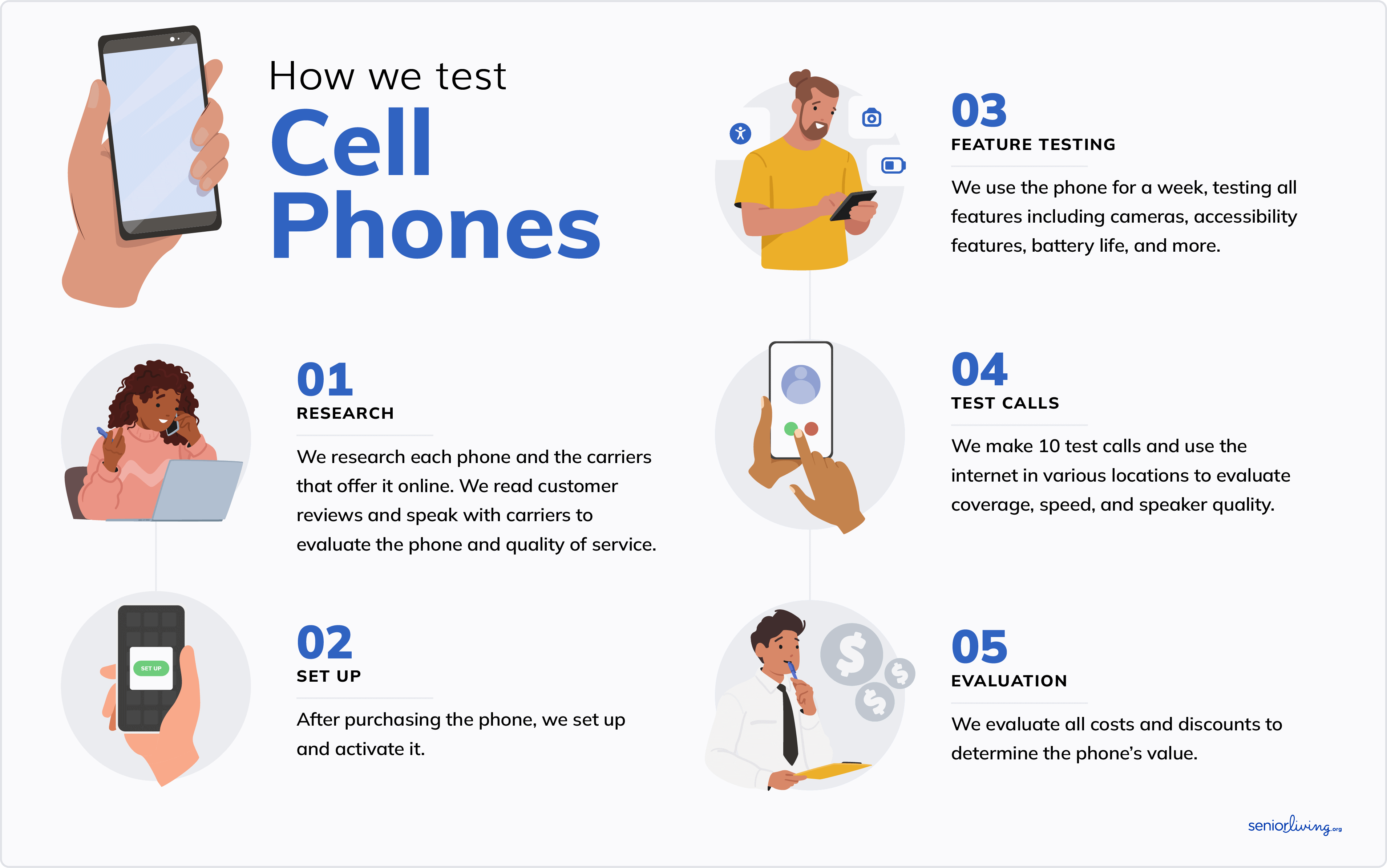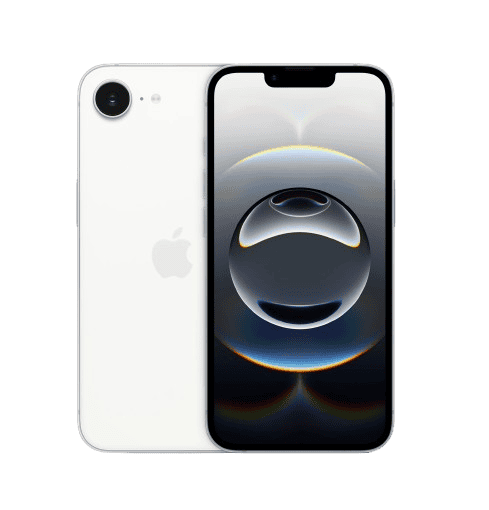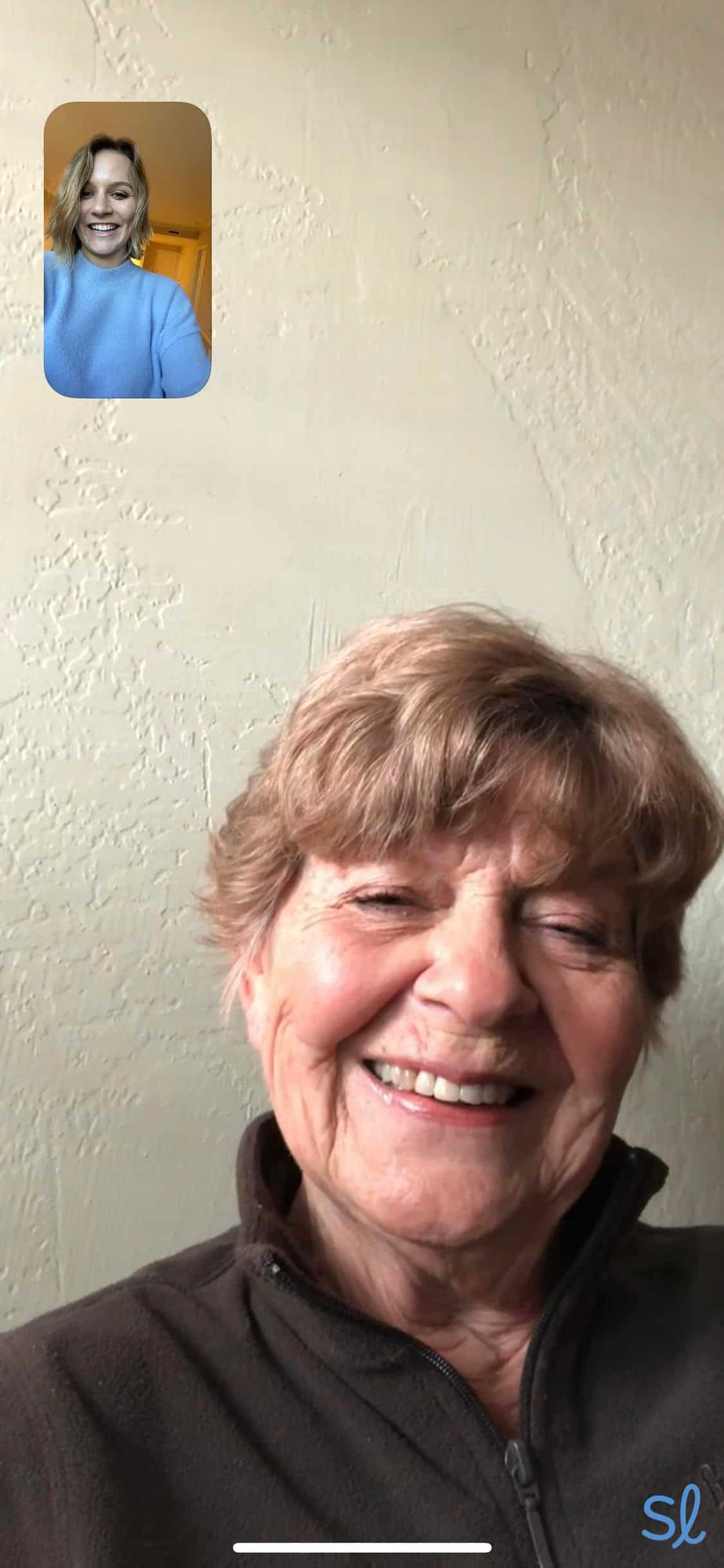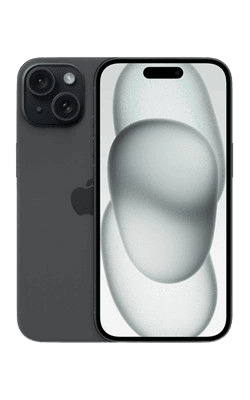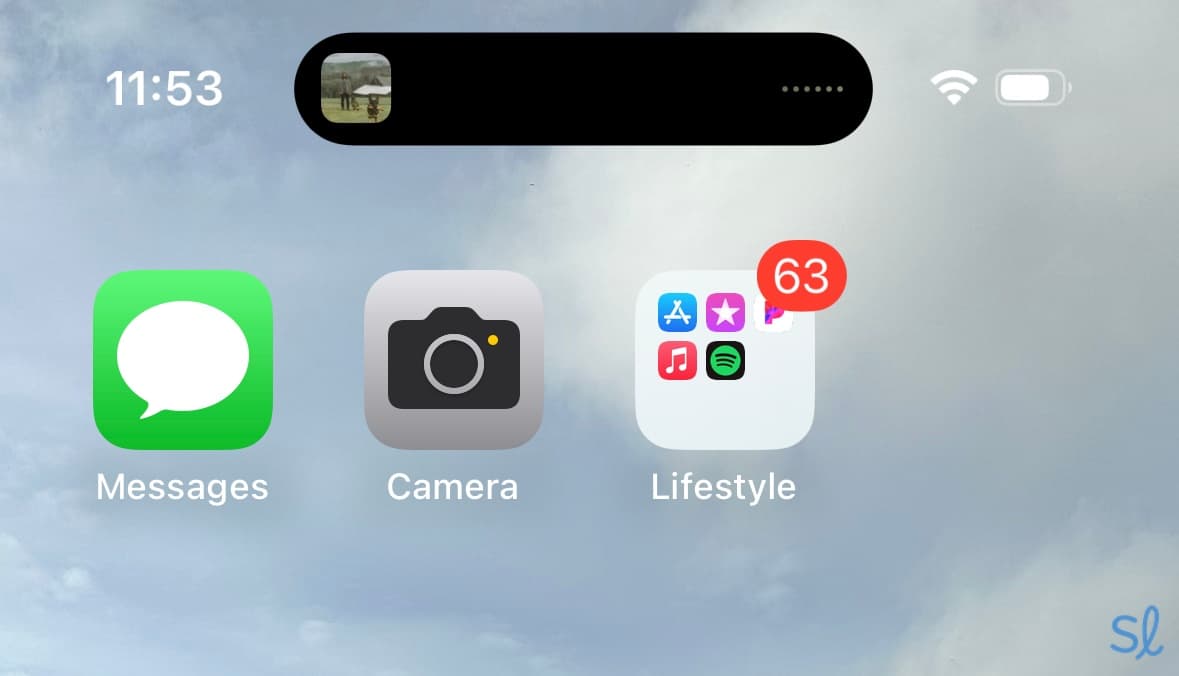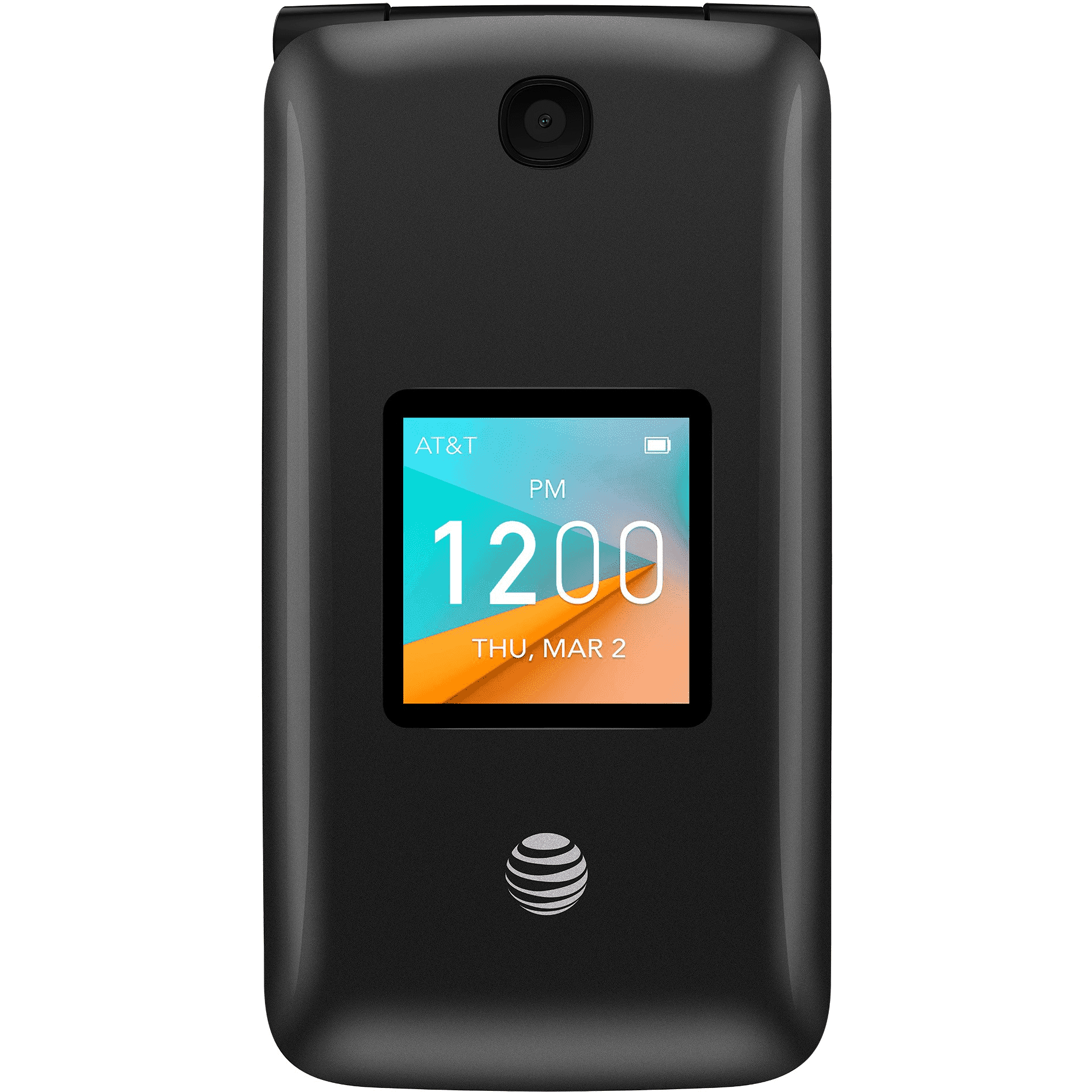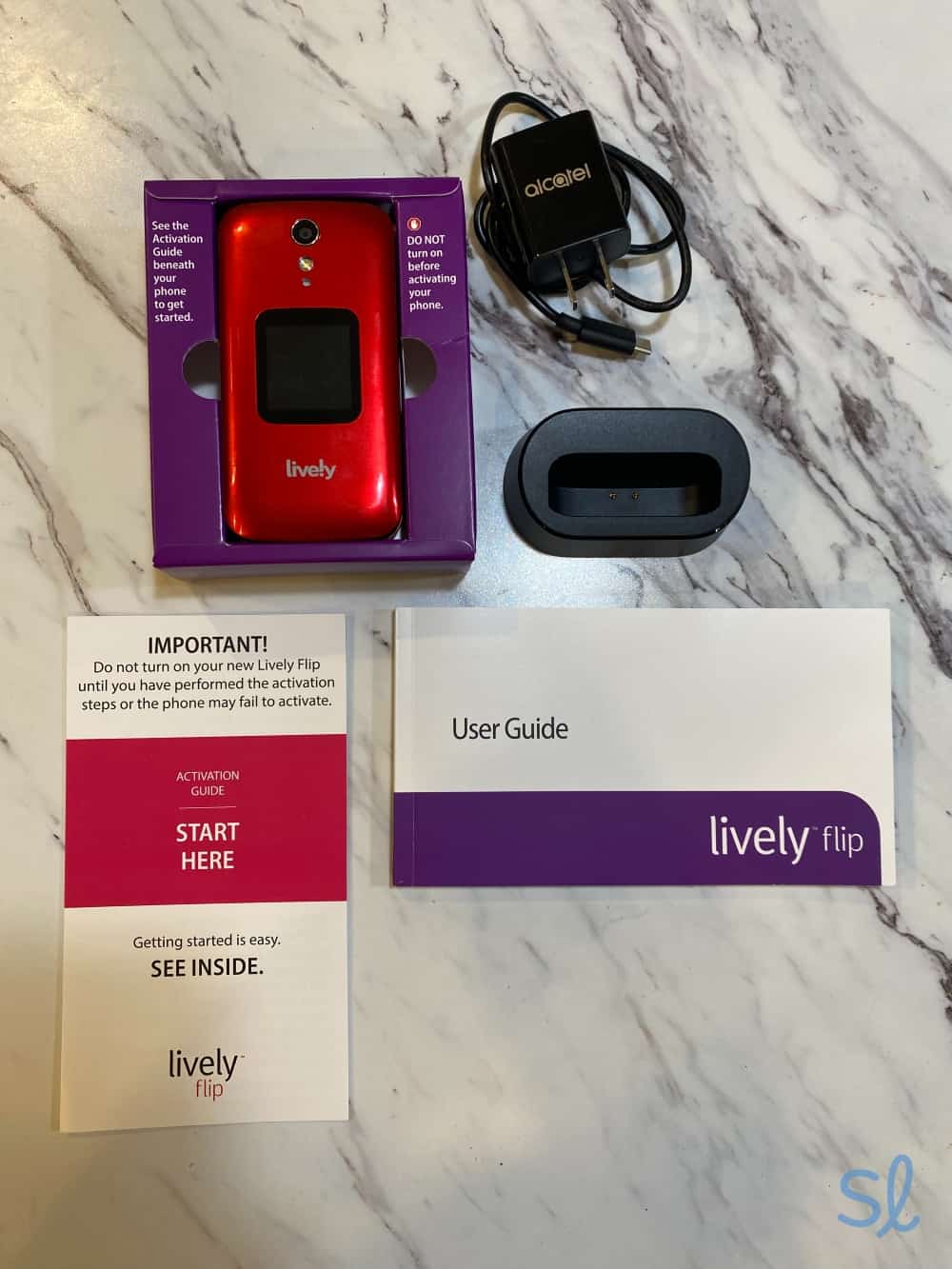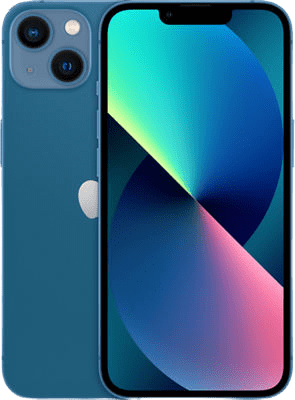The Best iPhones for Seniors, Tested and Reviewed by Tech Experts in 2025
Our favorite iPhone for seniors is the iPhone 16e, which delivers the most up-to-date technology at an affordable price of $599.99.
Our tech expert team evaluated 10 of Apple’s best iPhone models and narrowed down the list to our top picks for seniors.
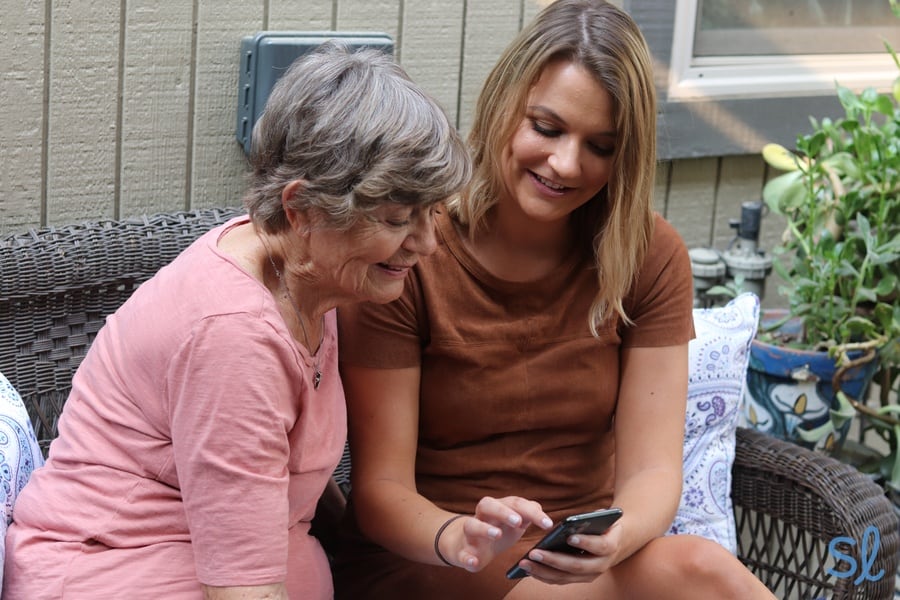
Showing my grandma how to use an iPhone
How We Tested the Best iPhones
Apple puts out new iPhone models every year, so finding the best iPhone for seniors required us to test and examine every model’s unique features. After our team researched the best models, my grandma and I used each iPhone, discussed our likes and dislikes, and got feedback from other seniors.
My grandma and I have been iPhone users for many years, so we’re familiar with the user experience and pros and cons of these products.
We spent a lot of time with each phone, taking photos and videos, trying health and safety features, and testing how accessible each phone is for seniors. Here is what our testing process looked like:
- We researched the most popular, affordable, and feature-rich iPhones online to narrow down our list. Then, we looked at available phone plans to ensure that each model was accessible through some of the most popular and senior-friendly carriers.
- We ordered our top picks, unboxed them, and tested them over two weeks.
- After over 200 hours of research and testing, we narrowed down our list of the best iPhones for seniors to just three models.
How We Chose Our Top Picks
Like all our top cell phone picks for seniors, our top iPhones had to meet certain criteria to make the cut. We considered a variety of factors, including price, senior-friendly features, call quality, and screen size. Our top three criteria, which you will see discussed for each iPhone below, are:
- Accessibility: We examined each iPhone to determine how easy it is for a senior to handle it physically, turn it on and off, and use its basic and advanced features. We also evaluated accessibility features.
- Durability: We look for iPhones that are made from strong, durable materials and include extra precautions to make them as resistant to water, dust, and fall damage as possible.
- Camera quality: Taking high-resolution photos is one of the smartphone features that appeals to many seniors. We examined the specs of each camera and tested them to see what the photo and video quality look like.
Why Trust Us
Our senior tech experts try the latest products and tech for older adults. We’ve spent hundreds of hours testing and reviewing phones for seniors — including various iPhone models — as well as the cell phone plans available through regional and nationwide carriers.
We consult with seniors to learn about their personal experiences with different phone models, including what they like, what they dislike, and features they would like to see in the future.
SeniorLiving.org is supported by commissions from providers listed on our site. Read our Editorial Guidelines
- Costs $599.99
- Up to 22 hours of battery life
- 48 MP camera
- Face ID and SOS severe car crash detection
- Costs $729.99
- Up to 80 hours of audio play without needing a charge
- 48 MP camera
- Face ID and SOS severe car crash detection
- Costs $829.99
- Up to 27 hours of talk time
- 48 MP main camera
- Face ID and SOS severe car crash detection
Contents
An iPhone can make life a lot easier if you have trouble with arthritis or find it difficult to read on smaller screens. The iPhone’s exceptional speakers and hearing aid compatibility also help provide a seamless hearing experience for those with hearing loss. So, which iPhones are the best for seniors?
Our tech experts tested and evaluated 10 of Apple’s best phones and narrowed down the list to our top picks for older adults. We selected models based on criteria like price, value, accessibility features, durability, and camera quality. After extensive research and testing, we chose the iPhone 16e, iPhone 15, and iPhone 15 Plus as our favorite models for older adults.
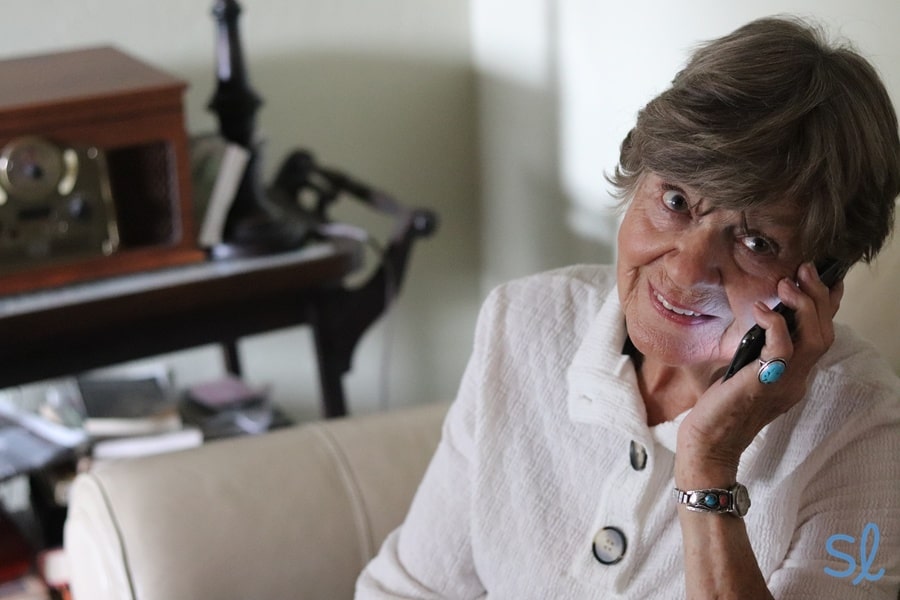
Our editor's grandma testing out an iPhone on AT&T's service.

-
1. iPhone 16e from Consumer Cellular - Best Basic iPhone for Seniors
 See Pricing Links to Consumercellularplan.com
See Pricing Links to Consumercellularplan.comWhat we like most
- Costs $599.99
- Up to 22 hours of battery life
- 48 MP camera
- Face ID and SOS severe car crash detection
 iPhone 16e from Consumer CellularSee Pricing Links to Consumercellularplan.comOverview:
iPhone 16e from Consumer CellularSee Pricing Links to Consumercellularplan.comOverview:Apple iPhone 16e
The iPhone 16e is an advanced yet easy-to-use phone for seniors with almost all the features of the iPhone 16, but with a price tag that’s $200 cheaper. It includes a 48 MP camera, Face ID (so you can unlock your phone by holding it in front of your face), voice assistant, and all of Apple’s industry-leading accessibility features.
Expert InsightsFrom Taylor Shuman, Senior Tech ExpertAll three of the iPhones that we recommend for seniors (and all newer iPhones, from the iPhone 14 and later) come with automatic severe crash detection. So if you’re ever in a crash and are unresponsive, your iPhone will contact emergency services and any loved ones you designate as emergency contacts as well.The 16e’s 6.1-inch display should be plenty big enough for older folks who have trouble reading, but some iPhones have even larger screens (the iPhone 15 Plus has a 6.7-inch screen). But my grandma and I found the bright, crystal-clear Retina HD touch screen easy to see and grip. Plus, I was able to stream 4K YouTube videos and FaceTime my grandma in high definition. In case you’re the family photographer, the 16e comes with a 48 MP camera and 128 GB of memory (or up to 512 GB if you pay more).
FaceTiming with my grandma on our iPhones
Pros & Cons:Pros About iPhone 16e from Consumer Cellular
- Has all the standard iPhone features, such as regular security updates and fast speeds
- Crisp Retina HD display for easy reading
- Face ID for easy access without passcodes
- Professional camera with 4K video streaming
- Built-in voice assistant
- Hearing aid compatibility for seniors with hearing loss
- Water- and dust-resistant design
Cons About iPhone 16e from Consumer Cellular
- No MagSafe wireless charging capability
- Screen isn’t as large or bright as the iPhone 16
- Doesn’t come in fun colors like many iPhones, only white and black
- More expensive than our previous favorite, the iPhone SE
- Like the iPhone SE, the 16e has only one rear camera lens
Our Hands-on Experience:Accessibility
The 16e unfortunately doesn’t come with Touch ID like the iPhone SE did. But many seniors find Face ID, which unlocks your phone with your face, convenient once they get used to it. Some users prefer Touch ID over Face ID, as the latter sometimes can’t recognize you if you try to use your phone in a dark room or while you’re wearing sunglasses.
» Related Reading: How to use FaceTime
That said, I found that if my finger was wet or I used the wrong finger, Touch ID didn’t work. Fortunately, iPhones also let you use a passcode if you prefer.
The iPhone 16e is one of the easiest iPhones for seniors to set up. To power it up, you simply press the large rectangular button on the upper right side of the phone until you see the Apple icon on the screen. Then swipe up on the screen to find the home page and choose your language and country. From there, your phone will guide you through the rest of the process, including setting up your Apple ID and Face ID.
» Further Reading: Best Smartphones for Seniors
The iPhone 16e — and all iPhones — also have a ton of built-in features that make it easier for seniors to use their phones with fewer issues. When my grandma went into the Accessibility section of the settings menu, she was pleasantly surprised by all the options available.
For example, the VoiceOver feature lets you tap once on an item on your screen and have the phone read it out loud to you. You can then double-tap the item to open it or proceed. My grandma loved this feature because she occasionally clicks on things accidentally and then struggles to get back to the previous screen.
The iPhone 16e can also increase safety with its ability to customize access to your home, such as to a security system or garage door opener. You can set your iPhone to give caregivers or loved ones access to these systems only at the specific times you choose, so you can keep your permanent passwords and other access information safe.
Durability
Unlike some earlier iPhone models, the iPhone 16e has Ceramic Shield glass, supposedly stronger than older cell phone screen glass and more resistant to scratches and breaking. It’s possible that dropping your phone could still result in scratches on the sides of the device, but the matte surface on the back of the 16e is fairly scratch-resistant. Putting a case on your iPhone 16e is still a good idea, though.
We should point out that while the iPhone 16 is larger than the iPhone SE, the 16e does weigh less than most other models, like the iPhone 15 Plus. That makes it easier to keep hold of for people who have trouble with hand strength or dexterity.
FYI: How much storage does the iPhone 16e’s 256 GB give you? That amount of storage would allow you to store more than 20,000 photos or over 100 videos!
The iPhone 16e is water resistant to depths of up to 20 feet, and it is sealed against dust. I’m notorious for dropping my phone in water, so I can attest to this water-resistant design. As long as you’re careful with your phone and willing to invest in a case, you can probably enjoy your iPhone 16e for years to come.
Camera Quality
The iPhone 16e has a decent camera, although it only has the one rear lens, which means it isn’t great at switching between wide-angle and telephoto. Like all iPhones, it has both front- and rear-facing cameras for standard photography and selfies, and video quality is generally excellent as well.
A photo of a furry friend taken with the iPhone
-
2. iPhone 15 - Best Advanced iPhone for Seniors on a Budget
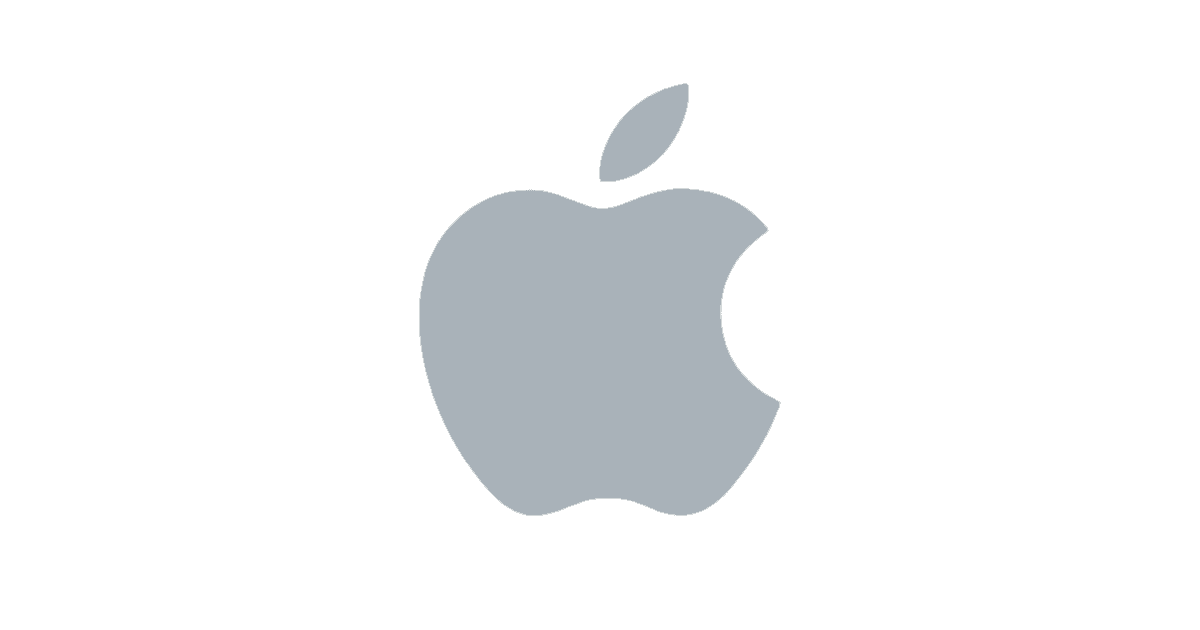 See Phone Links to Att-promotions.com
See Phone Links to Att-promotions.comWhat we like most
- Costs $729.99
- Up to 80 hours of audio play without needing a charge
- 48 MP camera
- Face ID and SOS severe car crash detection
 iPhone 15See Phone Links to Att-promotions.comOverview:
iPhone 15See Phone Links to Att-promotions.comOverview:Apple iPhone 15
It isn’t just the senior features that make the iPhone 15 a hit with older smartphone users. Its bright Super Retina XDR OLED display makes it a great choice for those with vision issues. During testing, I noticed that text, images, and videos were bright, large, and easy to see. Like the iPhone 16e, the iPhone 15 has a 6.1-inch screen, Ceramic Shield protection for break- and water-resistant glass, and Face ID technology.
Did You Know? More than half of American smartphone users choose iPhones over Android phones.1
The iPhone 15 is not the newest generation of iPhone, so it’s now one of the more affordable high-end iPhones on the market at $729.99 (128 GB). As long as internal storage is not a major issue, you can save a bundle by opting for the 128 GB iPhone 15, especially compared to the iPhone 15 Plus.
Pros & Cons:Pros About iPhone 15
- One of the most affordable iPhones
- 6.1-inch screen for easier reading with larger type
- 48 MP front- and rear-facing camera system
- Break- and water-resistant screen glass
- M3/T4 hearing aid compatibility for seniors with hearing loss
- Crash detection, emergency SOS, and roadside assistance
- Comes in five colors
Cons About iPhone 15
- Might be a little large and clunky for some seniors
- 128 GB of storage can get used up quickly
- Lack of home button and Touch ID comes with a learning curve
Our Hands-on Experience:Accessibility
My grandma loved the vibrancy and bright colors of the iPhone 15’s Super Retina XDR OLED display. The True Tone automatic brightness adjuster makes it easy for most seniors to read in just about any lighting environment. The iPhone SE, our previous pick, didn’t have this easier-to-read screen.
» Resources for Seniors: Smartphone Apps and Resources for People With Vision Loss or Impairment
My grandma felt a little confused when we first unboxed the iPhone 15. She had more experience with older iPhones, which feature a home button, so the switch to the iPhone 15 wasn’t perfectly smooth.
She liked the Face ID feature in theory, but in practice she found that it wasn’t always convenient or reliable. For example, when the phone required her Face ID to authorize a purchase, the phone couldn’t recognize her face from a few different angles or in darker lighting. Eventually, she put in her passcode. That said, Face ID is a great feature for seniors with mobility issues, even though it comes with a learning curve.
Senior Savings Tip: Looking for a discount on the things you like best? Check out our senior discount guide for special deals on travel, leisure, eating out, and more!
Like the other iPhone models on our list, the iPhone 15 has plenty of accessibility features. I was able to change text size, zoom in, reduce transparency, or use the iPhone hands-free with the sound of my voice. For those with hearing loss, your iPhone can display subtitles and captions, transcribe audio messages, connect with hearing aids, and much more.
» Related Reading: Best Hearing Aids in 2025
Durability
Like most iPhones, the iPhone 15 is best protected when it has a case. The Ceramic Protection screen is resistant to fall damage, and it is also water- and dust-resistant. I wasn’t throwing the iPhone around during testing, but I experienced a few accidental drops, and the phone didn’t show much wear and tear.
» Also Read: The Best Senior Phone Plans
My grandma and I agreed that the iPhone 15 felt sturdy to hold, but also a bit heavy. Weighing 6.02 ounces, the iPhone 15 is slightly heavier than the iPhone 16e (5.89 ounces), but still not nearly as heavy as the iPhone 15 Plus (7.09 ounces). Fortunately, my grandma and I had no issues holding and using the iPhone 15 for extended periods.
Camera Quality
The iPhone 15’s 12 MP dual-camera system is excellent. It’s a pretty big step up from the iPhone SE, especially if you like to take selfies. My grandma and I liked using the many camera features, including cinematic mode, time lapse, and slow motion.
We could even do the 0.5x zoom-out feature to make sure everything fits into the frame without having to step back. If you compare the photo taken below with the photo we took using the iPhone 16e, you can tell that the image is crisper and clearer, and the colors are more vibrant.
A photo taken using the iPhone 15 camera
-
3. iPhone 15 Plus - Best Battery Life on an iPhone
 See Pricing Links to Att-promotions.com
See Pricing Links to Att-promotions.comWhat we like most
- Costs $829.99
- Up to 27 hours of talk time
- 48 MP main camera
- Face ID and SOS severe car crash detection
 iPhone 15 PlusSee Pricing Links to Att-promotions.comOverview:
iPhone 15 PlusSee Pricing Links to Att-promotions.comOverview:Using the iPhone 15 Plus
The iPhone 15 Plus boasts a large screen (6.69 inches), and the aluminum casing is both durable and light compared to phones with a similar screen size. That said, the iPhone 15 Plus is still heavy at 7.09 ounces. The weight is partly due to the phone packing a large battery that offers a talk time of up to 27 hours. During testing, the 15 Plus’ battery life was noticeably longer than my iPhone’s battery life. (I have the 14 Pro, which is no longer sold by most carriers.)
» Learn About: Best 5G Phones for Seniors
With a starting price of $829.99 (128 GB), you might think that the iPhone 15 Plus is outside your price range. Fortunately, if you get your phone through AT&T or other major carriers, you can get your new iPhone 15 Plus for as little as $23.06 per month. The iPhone 15 Plus may be too much phone for older adults who just need a simple smartphone, but it is a good choice if you want a large, bright screen and a phone that doesn’t need to be charged very often.
Pros & Cons:Pros About iPhone 15 Plus
- Talk time of up to 27 hours
- 6.69-inch screen
- 48 MP main camera with Dynamic Island
- A16 Bionic processing chip
- USB-C charging port
- Roadside assistance and emergency SOS via satellite
Cons About iPhone 15 Plus
- High starting cost
- Large size and weight may be too cumbersome for some seniors
- Not a huge upgrade from the iPhone 14 Pro
Our Hands-on Experience:Accessibility
My grandma and I immediately noticed the similarities between the iPhone 15 Plus and my personal iPhone, the iPhone 14 Pro. The 15 Plus has a bigger screen, which my grandma liked for reading texts and surfing the internet, but, once again, she felt that the phone was a bit heavy to hold for extended periods. Otherwise, she had no issues navigating the iPhone 15 Plus.
» Further Reading: Easiest Cell Phones for Seniors to Use
Along with all of the iPhone 15’s accessibility features (including Face ID), the iPhone 15 Plus has a Dynamic Island. This is a small notch at the top of the screen that hides the front-facing camera and Face ID sensor. It also functions as a one-stop shop to get notifications and access your favorite apps that are running in the background.
I like the feature for older adults, because you can simply tap the notch to go straight to apps you’re using, such as Facebook and YouTube, without having to scroll through dozens of apps. The Always On display also made it easier for my grandma to check the time, date, weather, and even outdoor air quality without opening the iPhone.
The iPhone's dynamic island can provide quick access to apps like Spotify.
As with the iPhone 16e and iPhone 15, the iPhone 15 Plus includes SOS emergency services for two years. We tested the roadside assistance and emergency SOS features by going to an area with no Verizon signal, and they both worked great. We connected with a roadside-assistance agent within about five minutes and an emergency-response agent in less than one minute.
This feature significantly increases peace of mind. If you’re in an area without cell service during an emergency, the phone connects to a satellite to call for help. This makes the iPhone 15 Plus a useful supplement for medical alert devices.
» Useful Resource: A 2025 Guide to Medical Alert Systems
Durability
The iPhone 15 Plus also features a strong glass Super Retina XDR OLED display screen. Not only does this make it extremely bright and responsive, but it also makes it resistant to water, dust, and scratches.
The reinforced aluminum casing may not be as strong as the iPhone 14 Pro’s stainless-steel exterior, but it does allow the 15 Plus to be a little lighter, despite the larger battery. The iPhone 15 Plus is similar in durability to the iPhone 14 Pro, but if you want to protect your investment, I’d recommend getting a good phone case. I didn’t experience any scratches, dents, or cracked screens during testing.
» Resource Guide: Cell Phones for Seniors: A Buyer's Guide
Camera Quality
The iPhone 15 Plus boasts the same camera system as my iPhone 14 Pro (48 MP/12 MP/12 MP). This means you can take amazing photos, videos, and selfies. As a bonus, the iPhone 15 Plus comes with some cool new features, such as a portrait mode that lets you focus on different faces or parts of the photo after the picture has been taken.
My grandma and I liked playing around with the camera, but we didn’t notice a big difference compared to photos I’ve taken on my iPhone 14 Pro. If you’re buying an iPhone for the camera alone, you could save yourself some money and enjoy the same quality with the iPhone 14 Pro if you can find a refurbished model.
A photo taken on the iPhone 15 Plus
Choosing the Best Phone Carrier for Your iPhone
Once you settle on an iPhone, you still need to pick the right cellular carrier. Whether this is your first smartphone or you’re thinking about switching carriers, here are a few things you’ll want to consider.
Paying for Your iPhone With the Major Cellular Carriers
Paying for Your iPhone Up Front
If you’ve got the cash, paying up front frees you from getting locked into a contract with a provider. These days, most major carriers with postpaid plans (where you pay your bill at the end of the month based on usage) don’t require a contract if you own your phone.
The advantage here is that you can always take your iPhone to another carrier if you’re not happy with your current service. Most carriers these days also have a bring-your-own-phone (BYOP) policy, so using your iPhone with another service won’t be a problem.
Paying for Your iPhone by Installment
The advantage here is you can always take your iPhone to another carrier if you’re not happy with your current service. Most carriers these days also have a bring-your-own-phone (BYOP) policy, so using your iPhone with another service won’t be a problem.
Data, Coverage, and Senior Perks
How you pay for your iPhone isn’t the only thing you need to think about when choosing a phone carrier. There are other things to consider, including data limits, talk and text limits, discounts for multiple lines, senior perks and discounts, and 4G/5G coverage. To save you some time, here’s a breakdown of how our favorite cellular providers for seniors stack up.
| Plan | Starting monthly price for one line | Contract | Data limits for top plans | Unlimited talk and text | 5G | Multiline discounts | Discounts for seniors |
|---|---|---|---|---|---|---|---|
| T-Mobile
Essentials Choice 55 |
$50 | No | Unlimited, but slower after 50 GB | Yes | Yes | Yes | Yes |
| Consumer Cellular | $20 | No | Unlimited, but slower after 50 GB | Yes | Yes | Yes | Yes |
| AT&T
Unlimited 55+ |
$40 | No | Unlimited, but slower at peak times | Yes | Yes | Yes | Yes |
| Verizon 55+ Unlimited | $45 | No | Unlimited, but slower at peak times | Yes | Yes | Yes | Yes, but only for Florida residents |
| Mint Mobile 55+ | $15 | No | Unlimited, but slower after 40 GB | Yes | Yes | No | No |
T-Mobile
We reviewed T-Mobile’s 55+ phone plans, with single lines starting at $50 per month with unlimited talk, text, and data available to anyone 55 and older. To learn more about how the company’s prices compare with other providers, check out our T-Mobile pricing guide.
Like all the other plans on our list, T-Mobile’s basic one-line plan comes with SD streaming and gets cheaper per line the more lines you add. One advantage that sets T-Mobile apart, besides no-frills pricing, is that the company currently dominates the 5G market with about 42 percent national coverage. Their closest competitor, AT&T, is at 18 percent.
Senior Saving Tip: If you’re into streaming, T-Mobile’s top-tier plans come with Apple TV+ included at no extra cost!
Throttling policies — when your provider slows your internet down at peak traffic times — remain a little murky for other major carriers, but T-Mobile is up front about it. You may notice a drop in speed, but only after you burn through 50 GB of data in a month.
Watch the video below to learn more about T-Mobile’s plans for seniors.
Consumer Cellular
Consumer Cellular is a postpaid mobile virtual network operator (MVNO) that has been around since 1995. Don’t be intimidated by the MVNO terminology. All it means is that Consumer Cellular doesn’t have their own wireless network, which is true of many cell phone plan providers. Instead, it uses the AT&T network, so you know you’re connected to one of the country’s largest carriers.
Consumer Cellular is known for its customizable and affordable plans that range from $20 to $50 per month with 1 GB to unlimited data limits, respectively. Keep in mind that if you want a single-line unlimited plan with Consumer Cellular, you’ll need to be 50 or older. Moreover, data speeds drop after about 50 GB. Many of Consumer Cellular’s plans are geared toward low-data users.
» Shop Unlimited: Best Senior Unlimited Cell Phone Plans
AARP members get a 5 percent discount on Consumer Cellular’s plans, which is a great perk. The carrier also has a great track record when it comes to customer service. If you want to know more about what to look for in your provider, take a look at our Consumer Cellular review.
AT&T
AT&T has great national 4G coverage (68 percent), so if you’re still on 4G and you live outside of town, that coverage alone may steer you toward the industry goliath.
When we tested AT&T’s Unlimited 55+ plan for seniors, we found that we got the best value when we signed up with a partner or family member. If you do the same, you’ll see your monthly rate drop by a solid chunk. It’s also very likely you’ll catch a deal from time to time on specific phones, even iPhones.
FYI: AT&T is a trusted nationwide carrier, which means you won’t have to worry about unexpected charges or scams targeting seniors
Verizon
Verizon’s 55+ costs $45 for one line. Where Verizon stands out is its national 4G coverage. Verizon claims to cover 98 percent of the U.S. population, which would make Verizon your go-to provider if you live off the grid.
I always have better service with Verizon in rural areas. Whether I’m camping, on the coast, or just in a small town far from a big city, I typically have better rural coverage with Verizon than I do with AT&T. If you’re into your 5G, on the other hand, Verizon’s 12 percent coverage is not their best selling point.
Unlike AT&T, you need to live in Florida to take advantage of Verizon’s cellular plan for older Americans. Even if you don’t, you still have an option. One thing we discovered in our complete analysis of Verizon’s cell service is that it has plenty of unlimited plans for customers of all ages.
Did You Know? Some cellular carriers let you bundle your mobile, internet, and TV services into one discounted bill. Check out our guide to the best internet plans to learn more.
Mint Mobile
Taking its lead from T-Mobile, Mint Mobile is straight-talking, a little sassy (Ryan Reynolds is the company’s public face), and all about the service. This isn’t a coincidence: Mint Mobile rents out T-Mobile’s towers, which gives it the best 5G coverage in the U.S.
Mint Mobile also offers a plan exclusively for seniors called Mint 55+. It costs just $15 per month and offers 5 GB of data, free international calls to select countries, and free hotspot data. Plus, customers 55 or older get free MINTech Advisor support to assist with any setup or tech questions you may have.
Even if you don’t want the 55+ plan, all of Mint Mobile’s plans are pretty cheap. Mint has made a name for itself with its basic plan, which costs only $15 per month. But even Mint’s most expensive unlimited plan, at $35 per month, will fit most budgets. For comparison, that’s still $15 less per month than T-Mobile’s cheapest unlimited plan for seniors.
Did You Know? If you feel overwhelmed reading all the prices for different phones and plans, take a break by checking out these 13 things that are free for seniors.
The primary difference is that Mint’s plans are all prepaid, meaning you buy your minutes and data as you go. As we found out in our full review of Mint Mobile’s plans, you also have an incentive to buy in bulk. When you buy 12 months of Mint’s service up front, for instance, you continue to pay the introductory rate of $30 per month. Otherwise, your monthly bill will shoot up by $5 to $10.
» Learn More: Best Prepaid Phone Plans for Seniors
Does Apple Have a Senior Mode?
iPhones have a built-in senior mode — called Assistive Access — for older adults and those who may have difficulty using smartphones due to cognitive decline or disabilities. All essential iPhone apps, such as weather, mail, and photos, are designed to work with Assistive Access, and many apps you can find on the iOS app store are also compatible.
FYI: According to a survey conducted by Fable, 81 percent of respondents report that accessibility barriers greatly reduce their ability to enjoy their smartphones.2
Assistive Access is primarily designed to make things on your iPhone easier to see and interact with. Icons, images, and text look larger, important actions are more identifiable, and it’s generally easier to navigate the phone and be aware of what you can do on any given screen.
How to Set Up Assistive Access
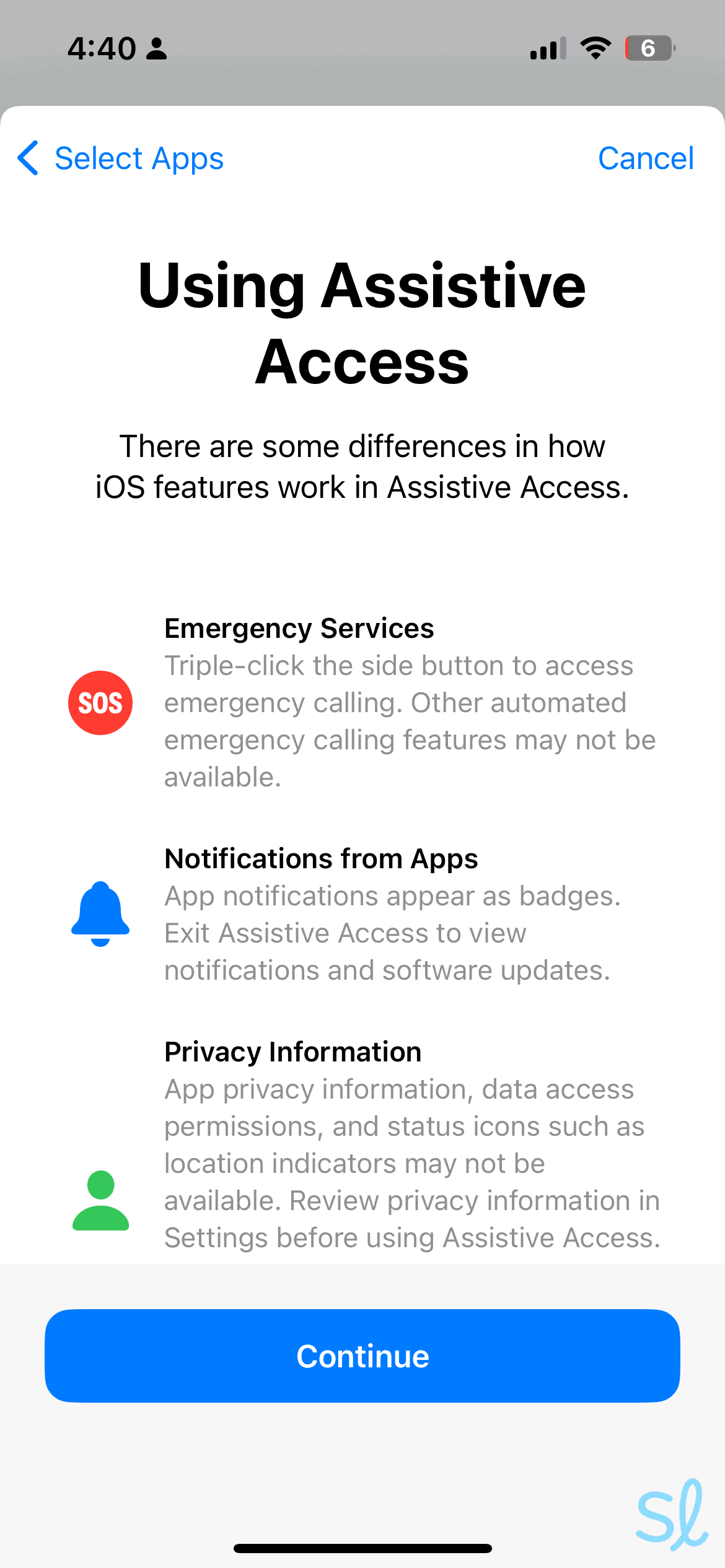
Using Assistive Access on an iPhone
We’ll go through the steps to set up Assistive Access on your iPhone, but it may be a good idea to get the help of a trusted caregiver if you’re unsure about following these steps on your own.
- Open the Settings app.
- Scroll down to the third section and press Accessibility.
- Scroll down to the bottom section (General) and press Assistive Access.
- Press Setup Assistive Access or Start Assistive Access.
- Enter your passcode (if applicable).
- Press Continue.
- Confirm that the Apple ID shown is associated with the primary user of the device and then press Continue. If you need to change the Apple ID, press Change Apple ID before continuing.
- Choose whether you’d like icons to appear in Rows or Grids (Apple indicates that Grids may be more prominent), and then press Continue.
- Select which apps you want to be optimized for Assistive Access. Keep in mind that many apps may ask you to make additional choices or enable or disable specific features.
- Once you’ve selected all the apps you want to be optimized for Assistive Access, press Continue.
- The next screen will provide you with additional information about how Assistive Access works and the features you can use with it. Once you’ve read through this information, you can press Continue.
- If you have a passcode, fingerprint ID, or Face ID enabled, you’ll need to use one of them to confirm that you are the primary user of the device. Press Continue when ready or press Change Security Settings.
- Set a passcode that will be used to exit Assistive Access.
- Select Set Recovery Apple ID if you want a backup method in case you forget your passcode, or press Not Now to skip this step.
- The next screen will tell you how to exit Assistive Access on your iPhone. Press Continue when ready.
- Finally, press Start Using Assistive Access or, if you want to start using it another time, press Enter Later.
- If you pressed Enter Later, you can begin using Assistive Access at any time by going back to Settings > Accessibility > Assistive Access > Start Assistive Access.
Keep in mind that these are just the basic steps to set up Assistive Access, and you may find that your iPhone feels quite limited without additional changes in settings.
When we wanted to take screenshots of the large icons after starting Assistive Access, for instance, we realized that the traditional screenshot method on the iPhone 15 (pressing the Volume Up and Power buttons simultaneously) didn’t work. Instead, we needed to go through additional steps to add Assistive Touch in Settings before we could take screenshots in Assistive Access.
That said, Assistive Access does make the iPhone extremely easy to use. Rather than swiping up to open the home screen, for example, we could simply press a large Open button at the bottom of the screen. It’s a great feature for older adults with vision loss or those who struggle to remember how to do things on their phones without on-screen guidance.
More Cell Phone Resources for Seniors
If you’re looking for a certain type of cell phone or you just want to compare all the options, check out our resources below. We’ve tested, compared, and ranked cell phones for a variety of different needs.
- Best Free Phones for Seniors
- Best Flip Phones for Seniors in 2025
- Best Cell Phones for Visually Impaired Seniors in 2025
- Best Cell Phones for Seniors With Hearing Loss
- Best Cell Phones for Seniors With Dementia
- Best Android Phones for Seniors
- Best Big-Button Cell Phones for Seniors
- Best Cheap Cell Phones for Seniors
- Best Samsung Phones for Seniors
- Best Voice-Activated Cell Phones for Seniors
- Best Unlocked Phones for Seniors
- Best VoIP Phones for Seniors
Frequently Asked Questions About iPhones for Seniors
-
Which is the cheapest iPhone for seniors?
The cheapest iPhone on our list is the iPhone 16e , which starts at $599.
-
How long will my iPhone get updates?
Apple will offer updates and support for iPhone 15 until 2028 and updates for the iPhone 15 Plus and 16e until 2030.
-
Do I have to sign a contract to buy an iPhone through any of the carriers you mentioned above?
No. If you pay for your iPhone up front, you’ll pay for your cellular service month to month without a contract. If you opt for installments, however, you will be locked into a plan.
-
How much storage do iPhones come with?
Built-in iPhone storage varies from 128 GB to 1 TB. The more storage you get, the more expensive your iPhone will be.
-
Do iPhones come with accessibility features for seniors?
Yes, iPhones are well known for their senior-friendly accessibility features. If you go with any of our top models, your phone will come with full hearing aid compatibility, speech-to-text, text magnification, wide screens (some wider than others), and cutting-edge water and damage resistance.
-
Do I have to have an Apple ID (account) to switch to an iPhone?
No, you don’t have to have an Apple ID to use an iPhone. Also, iPhones these days are compatible with your favorite Android apps (Google Drive, Gmail, and even Google Photos), so you can sync your iPhone with the rest of your devices, even if they aren’t Apple products.
-
Business Insider. (2022). More Americans are using iPhones than Android phones for the first time ever, new report says — a major milestone for Apple.
-
Fable. (2024). Insights: Mobile accessibility.

